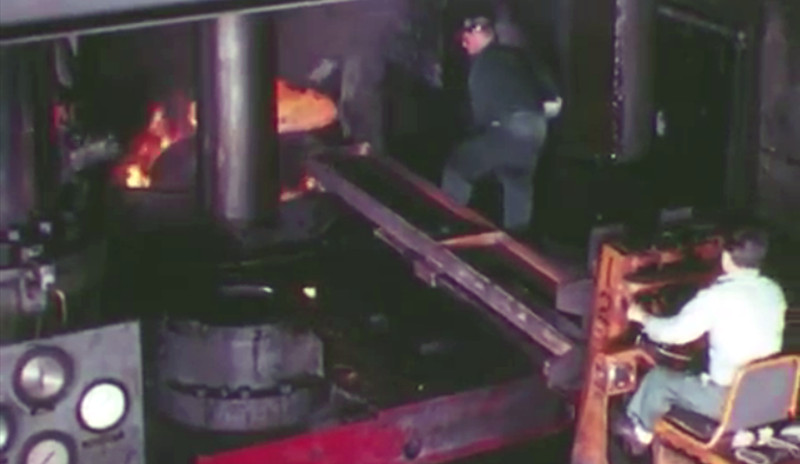When most of us think of forge work, the image that comes to our mind is likely to be a rather traditional one, of the village blacksmith’s shop, roaring coke-fired hearths, and an anvil ringing to the beat of hand-wielded hammers. Iron and steel, worked through the sweat of the human brow.
Precision metalwork probably doesn’t figure in there, yet there is another type of forging used to create some of the most highly stressed components on rockets, missiles, and aircraft as well as the more mundane ironwork of your garden fence. Drop forging allows reproducible shapes to be forged while maintaining tight control over the metallurgical properties of the finished product, exactly what is required for such high-performance applications.
The video below is a promotional film about drop forging in the aeronautical industry from the late 1950s, made for and about Wyman Gordon, still specialists in the field. With the charming optimism of the period and a very catchy title it goes into the detail of the plant, development, and quality control of a range of parts for the missiles and rockets of the day, and along the way shows the cutting edge of machine tooling in the days before CNC. A whole Periodic Table of metals are forged with an expertise probably not seen in many other places in the world.
There are also some sights you’d never see in today’s safety culture, for example a running press with men darting in to adjust the position of a forging while it is still moving. It’s not a short video, but definitely worth watching all the way through.
https://www.youtube.com/watch?v=CHKbAq_RtIY
For some reason this is the first time we’ve featured drop forging of beryllium here on Hackaday. We have however featured quite a few home-made forging hearths. This one made from a bathroom sink for example, gas hearths made from a soup can, or a paint can, or a coal-forge fabricated from steel. Stepping for a minute from behind the anonymity of the Hackaday writer’s third person, your scribe was particularly pleased though as the daughter of a blacksmith to see we’ve also covered what she considers the archetype of home-made hearths, one made from a brake drum.
Thanks [FredTheRanger] for the tip.
















If you like the more accessible end of forging work, have a look at Tim Lively’s video, focusing on “primitive” metalsmithing, where he uses only hand power and charcoal fuel:
https://www.youtube.com/watch?v=gVOF9UZSLK0
Checked with the what? https://youtu.be/CHKbAq_RtIY?t=902
https://en.wikipedia.org/wiki/Profilometer
Wikipedia – “The Heavy Press Program was a Cold War-era program of the United States Air Force to build the largest forging presses and extrusion presses in the world….The program began in 1950 and concluded in 1957…Eight of them are still in operation today, manufacturing structural parts for military and commercial aircraft.”
“There are also some sights you’d never see in today’s safety culture,”
you also don’t see the same level of injuries that were typical of the same era.
Absolutely, and don’t worry, that wasn’t railing against the safety culture but marveling at the crazy antics with a drop-forging press in the film. I have a first-hand view that power forging tools are to be treated with respect.
These are some of the jobs that have been eliminated by robots.
I like this one better for the point of scary forging work, personally I think the risk, more dangerous machines and accidents have just shifted location to one where people care less and unions are less well organized. But then, so has most of the manufacturing too.
https://www.youtube.com/watch?v=TMIK_fGCSIM
Thanks for posting this.
“It’s not a short video…” Shorter than most EEVBlog vids
This is a great video!
The opening shot of a traditional smith’s shop is shot at Old Sturbridge Village (www.osv.org) which is not altogether far from the Wyman Gordon plant in MA
It was interesting to see men walking around INSIDE of a moving press. Things sure have improved in terms of worker safety these days. Fascinating film, just a little cringe-worthy in places.
There’s just as much danger, maybe more, in walking thru a parking lot.
I’ve just called over there to the Grafton plant to try and get a tour and see the Heavy Press in operation – if I’m able to get a tour, any locals want to join me?
good grief
is that a heathkit 0-12 built into the test rig at 07:54 ??
great vid!
Did this video leave anyone else wondering how many folks could be put into a sheet of paper using a 50,000 ton press?
Depends if you want it to be letter sized or legal sized sheet.
– am enjoying [Jenny List]’s articles – well-written, engaging.& informative.
Thank you! :)
Thanks to Hackaday for featuring Wyman-Gordon. My father spent most of his career at McDonnell-Douglas (now part of Boeing) and their forging capabilities were truly unique. At one point, the wait time to get aircraft components such as titanium bulkheads for airframes could be a couple of years. We visited their facility in western MA and I must say that a 7-story tall (above and below ground) forging press is an awesome machine.